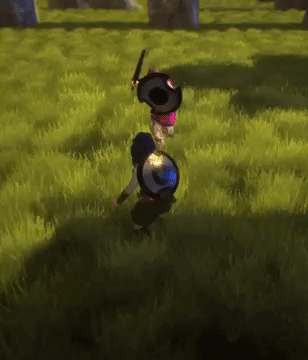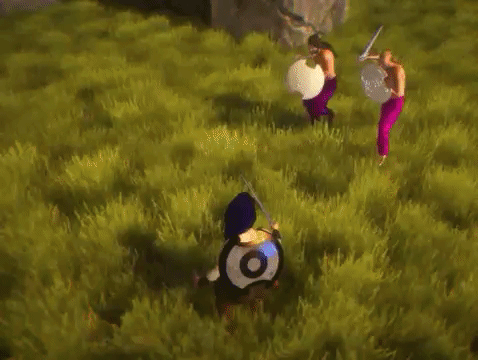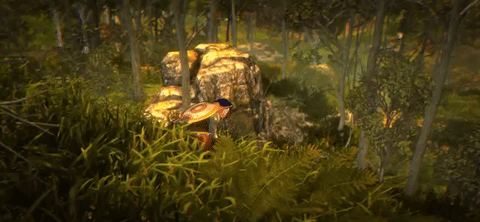Dev Blog 4 # Part I

This month kicked ass almost like this!
What a month! Indie game dev, especially for a project as generally ambitious, done in such conditions (details on that particular aspect someday), is clearly a rollercoaster. Between the highs and the lows, the roadblocks and frustrations, all the demanding work there is to be done, it's quite hard to ever feel bored. But what made September quite especially particular was that the stakes went a fair way up. Amongst some personal circumstances to carefully manage, there's been a few developments on the business side, with a few contacts, inquiries and offers extended towards Winterfall.
Now the funny thing about keeping a low profile for so many years and focusing 100% on the grunt work, is that you may forget (if you ever knew it in the first place) that if things do go well, eventually you will have exposure and with that, access a whole new level of play. As exciting as it's been to finally see Winterfall begin to attract that kind of business attention, I have to admit that it's also been a little disruptive of the quietly focused pace that has kept things going so far. It's taking a bit of time to adjust from the "inward" focus on the product, to expanding more outwardly towards communication and business. But it's also very fun.
Now, back to the game's actual development. And so, as of the last devblog we were dealing with a good bit of exciting features. This time around, a lot of groundwork on additional core mechanics has been done. Namely:
- Combat improved with particle effects and placeholder sounds
- Tracking system
- Vital Needs mechanics and stamina management
- Sprint, jump and slide added to controller
- Progressive construction mechanics
- Further inventory integration
- Additional biome blockouts
- New motion-captured animations
We will adress those few points over the span of several blog posts starting this week, rather than making one giant blog post with too much to digest. We will begin with the first two points in this list: Combat and the newly implemented Tracking system.
Combat, Particles & Style
Combat in Winterfall is 100% action, based on timing and movement, with many attacks available, with combo chains, blocks and dodges. It was therefore important to give a bit more feedback to the players by integrating sounds and particle effects. While sounds are somewhat crude at the moment, they do the job. Particle effects are more interesting however, and besides providing useful information as to what is happening on-screen, contribute to the "animated film" look Winterfall can have by being flashy, colorful and stylish, without being over the top. The entire idea is for them to inform of whether a hit has connected or not, and make it plain whether a shield, or weapon, or a body has been hit. They seem to deliver well on that front giving a bit more of a kinetic edge to the whole thing.

They also have a colorful and flashy styling that keeps building on Winterfall's signature aesthetics. The idea with Winterfall's looks was always to pursue a kind of "comicbook realism": realistic proportions and shapes, but energy and color for everything else, with an added dose of personality. Winterfall's visuals are often praised (thank you!) it's a very interesting phenomenon because assets-wise, we're on the same level as most other Unity developers making do with limited means. But it also goes to show how far along sheer style will take you. And so here we are with those nice, energetic particles, further building up said styling.

It is, however, an ongoing process of discovery. As the game beyond Combat will require a lot more work done on the visuals around the 3d and animations (all the user interface/user feedback visuals), we will have to find new solutions to keep things looking great and organic to Winterfall's style. And there will necessarily be an exciting challenge, for a game where so much can happen, to keep the play space clear and crisp, convey the information simply and efficiently, and so on, so that it all doesn't end up being overloaded with windows, texts and timers. We don't want Winterfall to end up being a number manager/info processing game.
Tracking System
Over the past few years, we have seen an entirely new genre rise up and fill up the charts: survival games. What I personally found interesting with survival games is that, by returning to simplistic game mechanics, they tend to be focused experiences, generally quite immersive, particularly if they sport large open environments. However, in a way they can be a step back design-wise since they are generally so simplistic with their mechanics, although it happened to be a much needed step back after a decade and a half dominated by mmorpgs with streamlined, bloated, impersonal that drove every aspect of the player's experience.
A good part of the inspiration for Winterfall came from the desire to make large, open worlds ready for adventure and exploration, in an immersive way, both in terms of environments and mechanics. But being raised by the Ultima school, I hold fondly in my heart the notion of a large world in which there are many game systems operating and interacting together to form a greater whole.
That is the direction to be followed by our overall Wilderness systems, which are a set of smaller systems that not only shape up aspects of gameplay in a slightly more structured way than the "run around until stuff happens" aspects of survival games, but also ultimately branch out into other components to create both life and play.

Tracking is quite simple. The landscape is full of resources, some in plain sight, some more elusive. Some you will know where to look for by scanning your surroundings, such as certain herbs, plants, forage and so on that will be indicated by regular environment features. Some will be static, you will find them once and will simply need to visit them to harvest resources from them, such as river or spring to get drinking water from, a quarry site or a cave in which to mine ore, or a ruin from which to extract stone. Some finally, will need to be tracked down and found, and this is where the tracking system comes in.

Tracking has its own segment of gameplay. Upon using the ability (if it is part of your character's assets), you will be pointed into the direction of your mark. It is then up to you to find your way to it, periodically making sure to refresh the trail to avoid getting off-mark. At the core, it is a very simple system. However, its design enables us to plug all kinds of "sensors" and checks within the whole process, from looking up a trail to making it to the destination, which themselves may feed data to other game systems.

As ever, the idea is that of modularity and communication between systems, so that gameplay creates gameplay, and engaging in a given interaction may be valued both for the interaction itself, but also for its ability to trigger a chain of events and gameplay goals.
That'll be all for today, but more will follow this week, following the list at the top of the post. Stay tuned, and thank you for your interest.














